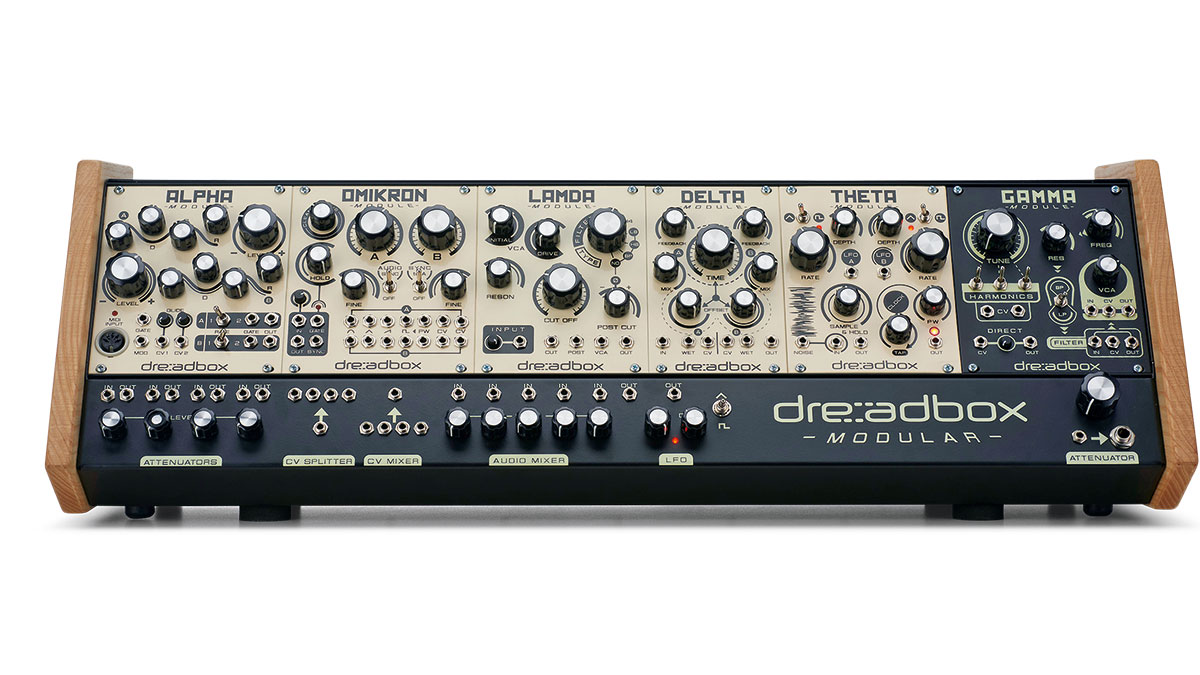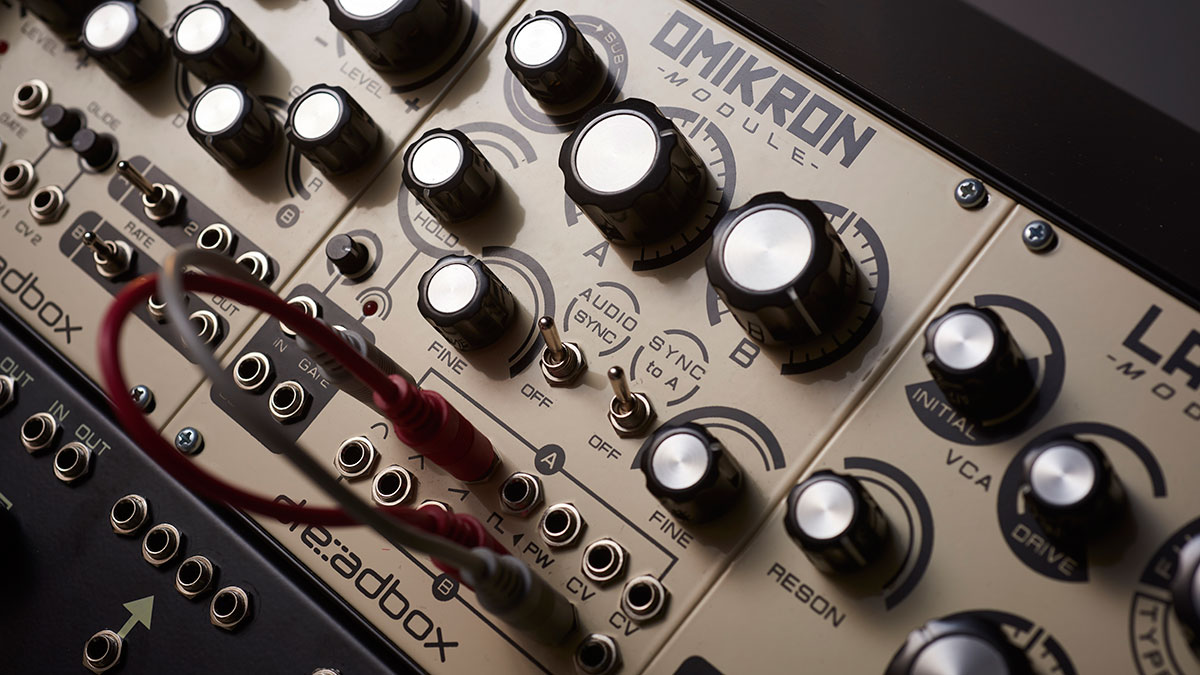MusicRadar Verdict
A solid system with some quirks that can be both alluring and frustrating. It won't please everyone, but it covers quite a bit of ground.
Pros
- +
The case is good-looking, solid and offers useful extra utility features.
Cons
- -
The Gamma module is weird and unpredictable – it doesn't play nicely with pitched material.
MusicRadar's got your back

Dreadbox Modular G-System

Dreadbox Modular G-System

Dreadbox Modular G-System
Regular readers will need no introduction to modular synthesis.
What started as a way of formalising the connectivity and interfacing of separate audio generators and processors over five decades ago, has seen a surge in popularity in recent years. This has gone hand in hand with a new wave of boutique hardware developers offering their take on older designs, or new ideas bundled into a modular format.
The allure of a new module has, to some, become an addiction - and modules bought on their own can be relatively cheap. Things get a little trickier, and more expensive, if you are making your first steps into the modular universe.
Dreadbox is based in Greece and, despite only creating hardware effects and synths for four years, has garnered a name for itself in the analogue community. Recent synths include the standalone Erebus and Hades.
Up for review here we have a 'pret-a-porter' modular G-System comprising six Dreadbox modules placed in one of its custom cases. There are eight Dreadbox modules available, with three other pre-configured systems from which to choose.
The system comes in its own padded carry case and is attractive, imposing and solid - in shades of black, cream and real wood grain. Although the 3U 122HP case fits the Doepfer Eurorack standard - and is far more than a rack with power - Dreadbox suggests you only populate it with its modules. In any case there is no free space available on this configuration, so we'll consider it a closed shop.
"Each module has multiple functions and, if the features of the case are included, there's a lot on offer."
Power is provided by an AC wall-wart PSU and there are 16 (all grey) patch cables included to get you going. To be honest though, you will need more.
Want all the hottest music and gear news, reviews, deals, features and more, direct to your inbox? Sign up here.
So what does each module bring to the table? Omikron and Gamma are the two primary sound generator modules.
Omikron is the more conventional, featuring two completely independent multi-waveform oscillators, each with course and fine-tuning, pulse width plus two separate CV inputs, and separate outs for each of the four waveshapes. Oscillator B can be sync'd to oscillator A, though the panel area to the left takes things further in this regard.
This so-called 'audio interface' area has a sub wave generator, audio to gate generator and audio sync convertor. The idea is that any audio source can be fed in, and with the three resulting signals available at different outputs (and controlled by a level trimmer and two pots).
Sadly, we couldn't get the LED to flash whatever we pumped in and we therefore decided to dive behind the front panel for further clues. Removing the panel revealed rather loose, and easily displaced power connectors - not ideal for portability, but not the problem here.
Pots and sockets are mounted on one PCB, with other components on a second parallel PCB behind. There was some movement in the connector between the two - more than one PCB spacer would have definitely helped here - but overall the component quality appeared high.
Sadly, the secondary features of this module still refused to play ball, though on paper they look promising. Incidentally, most of the modules have trimmers on their rear for calibrating various features. In each case, the manual for each module describes what they do, and whether or not it is a good idea to fiddle with them!
Quirky sounds
Gamma is a more unusual and unruly beast based around six parallel sawtooth wavegenerators. By default three of these are enabled, but oscillators 4 to 6 can be added to the mix via a set of switches.
The output of this section is routed into a resonant 12dB/octave filter via a VCA. A second VCA is fed direct from the VCO section. If you're expecting classic detuned 'supersaw' action then you'll be very disappointed, as this sound source falls much more readily into quirky sound design territory - and to such a degree that it is playable chromatically only in the lower reaches of its range.
The Harmonics switches are somewhat unpredictable in their behaviour, with their effect varying considerably on the overall tuning, and appear to create non-harmonic sidebands rather than specific elements in the harmonic series. The filter is full, and with bite, though passes into self-oscillation over a very short control range.
"TheAlpha is the most important module if you want to play your Dreadbox from a MIDI-equipped keyboard or DAW."
The main filter module on this system is the Lamda, an 8-pole (48dB/octave) state variable affair that also offers 2-pole low-pass and 4-pole high-pass modes. It would have been nice to see a 4-pole low-pass here, which would have allowed some 'classic' ground to have been covered as well, but the filter has an unusual feature up its sleeve.
The 8-pole modes allow you to tune a second resonant peak above or below the first using the Post Cut control. Its effect only really comes in to play at higher resonance settings, though it did a great job of turning the notch filter into something more formant-like, and works well with the mod wheel controlling cutoff - delivering a supremely nasty lead synth tone.
We couldn't get the cutoff CV input to track at 1 volt per octave, so turning the self-oscillating filter into a musical oscillator was out, though a special mention here should go to the post-filter drive circuit which sounds great, and adds real depth.
The last part of the equation in terms of full-on audio processing comes from the Delta delay module. Although of the digital variety, it leans very much towards the lo-fi end of the spectrum.
Delta consists of two parallel delays, each with their own mix, delay time offset and feedback controls. There is a centrally placed master delay time knob for real-time tweaking, but you also get individual wet-only outputs and CV inputs for modulating the delay times.
Routing an LFO to the CVs makes the creation of chorus or other modulation effects pretty straightforward. It would have been great to have had a simple onboard filter or EQ in the feedback path, and the possibility of even shorter delay times (sub 15ms), but overall this is a useful inclusion.
Clock on
Moving on to the less glamorous side of things we have Theta, a dual LFO, noise and sample-and-hold module. The two independent LFOs output triangle or square waveforms with a frequency range of 0.04-50Hz.
Each has a variable depth control, but we wish there were more (or variable) waveshapes. The lower half of the module has a dedicated white noise source and clock pulse generator with variable width control. The two are also hardwired to a sample-and-hold generator.
The clock might find many other uses, and features tap tempo, but not potential for MIDI clock sync. Unusually, the clock rate decreases when twisted clockwise.
Finally, the Alpha is the most important module if you want to play your Dreadbox from a MIDI-equipped keyboard or DAW. Alpha has a MIDI to CV/Gate converter and two 4-stage envelope generators.
The unit produces a single gate trigger, but offers two separate pitch volt/octave CVs with independent glide. A back panel DIP switch determines whether they output the same voltage or enables duophony (separate voltages for highest and lowest notes played). The envelopes are straightforward positive or negative, dual rate generators (the slow setting offering an AD/R cycle of up to 45 seconds).
The big question when buying a complete modular system such as this is whether it will deliver in sonic terms, but this has to be placed in a monetary context. You get massiveflexibility here, but £2,000 could also buy you a bunch of sonically complementary, and modestly-priced standalone synthesizers.
However, in many respects that misses the point of modular - everything can be connected, and in numerous ways. Looking at comparisons to this Dreadbox system in the modular world one can now turn to Roland's new/old System-500, the wide-ranging and good value offerings from Doepfer, as well as many others.
There is also the question of expandability, and whether you might be better creating your own multi-manufacturer system.
However, each Dreadbox module often has multiple functions and, if the features of the case itself are included, there's a lot on offer. Perhaps the only way to judge if it's for you is to demo one. It won't be a quick process - modular never is - but you may be surprised at the results, and it could be just what you need to liberate you from that dreaded mouse… and a few thousand pounds!